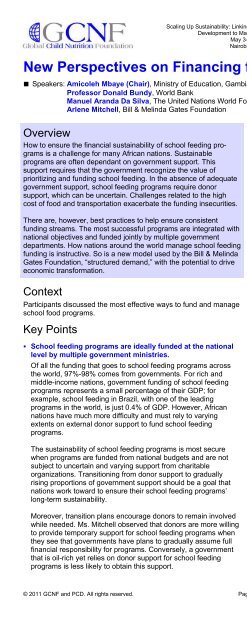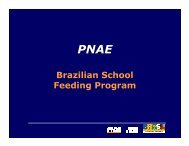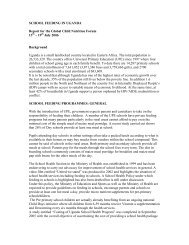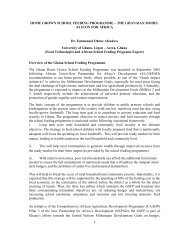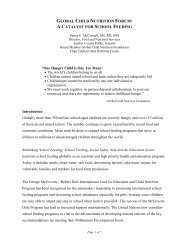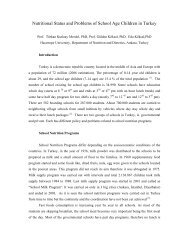EXECUTIVE SUMMARY - Global Child Nutrition Foundation
EXECUTIVE SUMMARY - Global Child Nutrition Foundation
EXECUTIVE SUMMARY - Global Child Nutrition Foundation
Create successful ePaper yourself
Turn your PDF publications into a flip-book with our unique Google optimized e-Paper software.
Scaling Up Sustainability: Linking School Feeding with Agriculture<br />
Development to Maximize Food Security<br />
May 3-7, 2011<br />
Nairobi, Kenya<br />
New Perspectives on Financing for School Feeding<br />
■ Speakers: Amicoleh Mbaye (Chair), Ministry of Education, Gambia<br />
Professor Donald Bundy, World Bank<br />
Manuel Aranda Da Silva, The United Nations World Food Programme (WFP)<br />
Arlene Mitchell, Bill & Melinda Gates <strong>Foundation</strong><br />
Overview<br />
How to ensure the financial sustainability of school feeding programs<br />
is a challenge for many African nations. Sustainable<br />
programs are often dependant on government support. This<br />
support requires that the government recognize the value of<br />
prioritizing and funding school feeding. In the absence of adequate<br />
government support, school feeding programs require donor<br />
support, which can be uncertain. Challenges related to the high<br />
cost of food and transportation exacerbate the funding insecurities.<br />
There are, however, best practices to help ensure consistent<br />
funding streams. The most successful programs are integrated with<br />
national objectives and funded jointly by multiple government<br />
departments. How nations around the world manage school feeding<br />
funding is instructive. So is a new model used by the Bill & Melinda<br />
Gates <strong>Foundation</strong>, “structured demand,” with the potential to drive<br />
economic transformation.<br />
Context<br />
Participants discussed the most effective ways to fund and manage<br />
school food programs.<br />
Key Points<br />
School feeding programs are ideally funded at the national<br />
level by multiple government ministries.<br />
Of all the funding that goes to school feeding programs across<br />
the world, 97%-98% comes from governments. For rich and<br />
middle-income nations, government funding of school feeding<br />
programs represents a small percentage of their GDP; for<br />
example, school feeding in Brazil, with one of the leading<br />
programs in the world, is just 0.4% of GDP. However, African<br />
nations have much more difficulty and must rely to varying<br />
extents on external donor support to fund school feeding<br />
programs.<br />
The sustainability of school feeding programs is most secure<br />
when programs are funded from national budgets and are not<br />
subject to uncertain and varying support from charitable<br />
organizations. Transitioning from donor support to gradually<br />
rising proportions of government support should be a goal that<br />
nations work toward to ensure their school feeding programs’<br />
long-term sustainability.<br />
Moreover, transition plans encourage donors to remain involved<br />
while needed. Ms. Mitchell observed that donors are more willing<br />
to provide temporary support for school feeding programs when<br />
they see that governments have plans to gradually assume full<br />
financial responsibility for programs. Conversely, a government<br />
that is oil-rich yet relies on donor support for school feeding<br />
programs is less likely to obtain this support.<br />
© 2011 GCNF and PCD. All rights reserved. Page 13<br />
In many African nations, government leadership changes hands<br />
every four or five years, and national priorities shift due to these<br />
changes. This presents a risk to school feeding program<br />
sustainability. In India, public demand for school feeding<br />
programs resulted in the Supreme Court directing state<br />
governments to introduce school feeding in all government<br />
primary schools. This is the best way to ensure that school<br />
feeding programs outlast the current political leaders.<br />
Advocacy is key to generating the strong public support for<br />
school feeding that is needed to influence lawmakers. Advocacy<br />
efforts should be more than propaganda, however. There is<br />
plenty of evidence to build a case that home grown school<br />
feeding programs support national economic development and<br />
other priorities. Evidence-based arguments are the best ways to<br />
engage the supply chain and other stakeholders and turn them<br />
into advocates.<br />
Evidence-based arguments can change the thinking of<br />
governments that believe that it is parents’, not the government’s,<br />
responsibility to feed children. Thinking needs to shift to the<br />
conviction that when parents are unable to meet this<br />
responsibility, it is the role of government to help. Moreover,<br />
governments should be made aware of how school feeding<br />
programs can help them meet the UN’s Millennial Development<br />
Goals by 2015.<br />
School feeding programs benefit most when funding comes from<br />
multiple government department budgets. That is fitting, since<br />
school feeding programs—particularly home grown programs<br />
that are linked to agriculture—serve multiple objectives besides<br />
education. These include health and nutrition, the protection of<br />
children, promoting agriculture, and economic development.<br />
Recognition of school feeding programs’ full value usually results<br />
in the sharing of financial support among Ministries of Education,<br />
Agriculture, Health, and <strong>Nutrition</strong>. When school feeding<br />
programs’ objectives are limited to education, however, funding<br />
comes just from a single source: the education budget. There is<br />
less money and increased vulnerability to budget cuts.<br />
But Ms. Mitchell pointed out that once a school feeding program<br />
is started in a country, it is extremely rare for it to be<br />
discontinued. Despite financial hardships, countries invariably<br />
find a way to sustain these valuable programs.<br />
The most successful school feeding programs reflect<br />
national priorities.<br />
Mr. Da Silva cited the following as important elements for school<br />
meal program funding:<br />
Clear, multi-sectoral objectives for the school feeding program<br />
that are linked to national objectives.<br />
National policy priorities of strengthening education, nutrition,<br />
and social protections. School feeding programs are least<br />
vulnerable when linked to national priorities.


